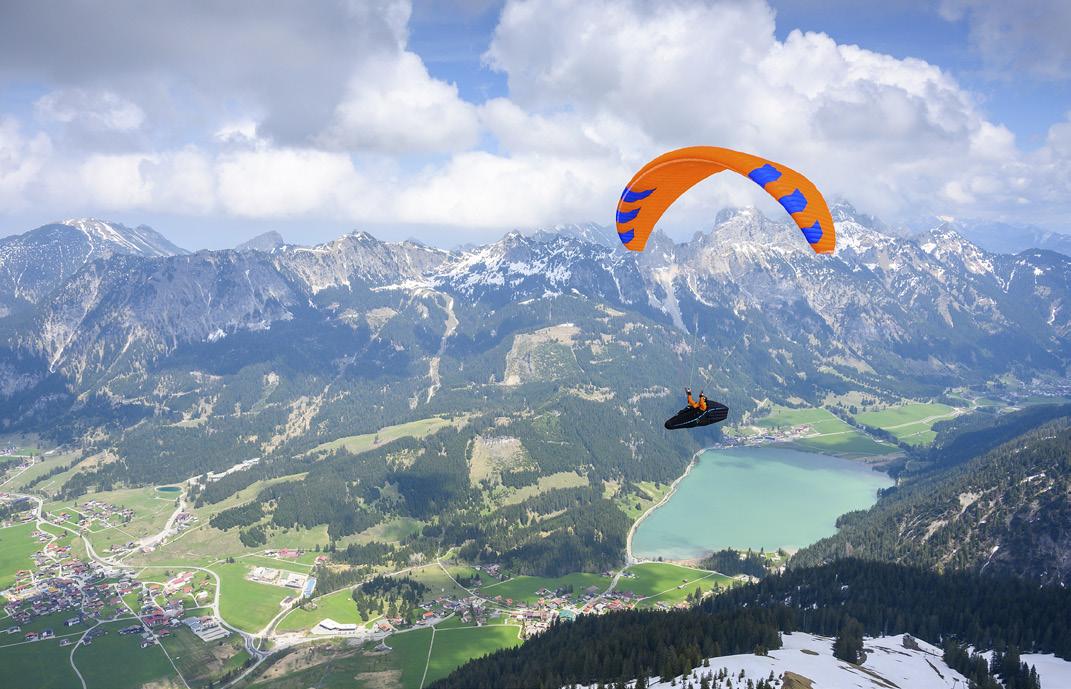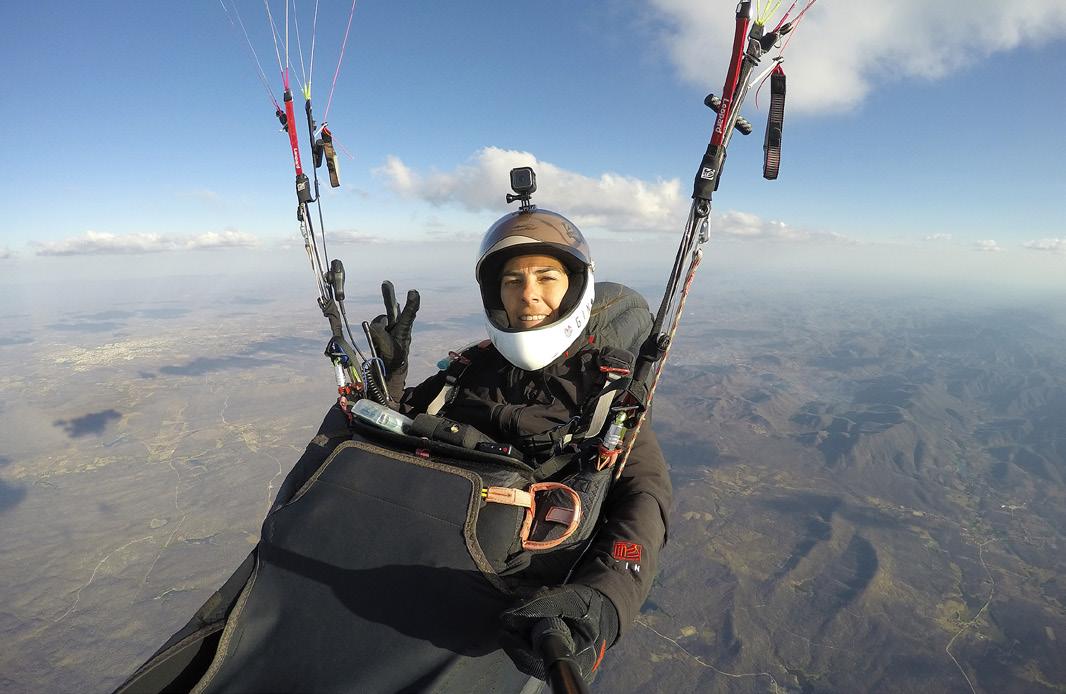
5 minute read
FOUR SEASONS IN THE ALPS
FOUR SEASONS IN THE ALPS
The Alps is a mecca for free flight and is perfectly set up for flying at any time of the year. Good infrastructure, cable cars, roads or trails to launch, public transport in the valleys, and a well-developed search and rescue system all set against a grand landscape of mountains, lakes, glaciers and forests. For first-time visitors here’s our introductory guide to making the most of the Alps.
Advertisement

XC SEASON Spring in the Alps – active air and strong climbs
Photo: Adi Geisegger
Spring
Spring in the Alps is when the XC season kicks off. You will often see huge flights done around mid-April, when the sun is getting stronger and much of the snow in the valleys has melted. The Alpine XC season then lasts all spring and summer.
For first-time visitors wanting to fly XC the Alps can be a little overwhelming. They present complicated terrain for flying with complex mountain meteorology. Start to get to grips with them by first understanding where you are in the bigger picture.
The central geographical division is the main Alpine ridge (the highest mountains in the range are in the centre) that runs west to east and divides north from south. The mountains in the Alps rise to 4,800m and are so big they block the weather; your XC flight will rarely cross the main range. Typically the climate in the northern Alps is wetter, the southern Alps drier and warmer. Spring arrives sooner in the south.
Secondly, are you west or east? This will also influence what climate you can expect: France’s Southern Alps are hotter and drier than Slovenia and Austria in the east. Thirdly, know that a lot of the time flying XC in the Alps means following the valleys and mountain ridges; only on very rare days will you be able to fly above the highest peaks.
Fourthly, mountain chains make their own weather and have a daily cycle: air flows in during the day, and out at night. Having a basic understanding of aspect, valley breezes, valley winds and the lee side is important.
Airspace aside, you can go XC anywhere in the Alps, but no matter how adventurous it feels, most of the time someone will have already been there and uploaded the tracklog. So before you head off on your Alpine XC adventure, check out the tracklogs online to look at typical routes for your location.
For pilots with less airtime a good way to start exploring the Alps is on an XC course. You fly during the day and get the theory lectures in the evening. Your confidence will build as your knowledge grows.
When: April to October
Info: Explore tracks and XC highways at xcontest.org, xcplanner.appspot.com, seeyou.cloud/planner and Leonardo at paraglidingforum.com

ADVENTURE RACE Hut-hopping during the Eiger Tour, a four-day adventure race through the Swiss Alps. The next edition takes place 8-11 July 2020 (eigertour.rocks)
Photo: Tobias Dimmler
Summer
Although the XC hounds chase distance all summer, summer is also adventure-race season in the Alps. While the Red Bull X-Alps (the famous 1,200km adventure race across the Alps on foot and by paraglider) is in its own elite league, there are plenty of other ways to get a dose of the adventure-racing action. In most of them you have a pre-set course or goal, and you have to make your
way round it as quickly as you can on foot and by flying. Many have obligatory rest stops where you must spend the night, while others allow you to spend the night out in the hills.
The Jura Hike-and-Fly (15-17 May, jurahikefly.ch) is an early-season accessible weekend event for pilots of all levels, in the Jura, a lower range of hills on the Switzerland/France border. Later that month Bornes to Fly (30 May 2020, bornestofly.fr) is a popular annual weekend hike-and-fly based around Annecy.
Also in France, the AirTour (13-21 June 2020, airtour.fr) is an annual 400km race that starts in St Hilaire. Meanwhile, the CrossAlps (crossalps.com) in Germany is a weekend event that happens every two years, next time this July. The Vercofly (26-29 August 2020, vercofly.ch) is a Swiss event that attracts an X-Alps-type crowd. The Bordair Race (bordairline.com) is an established series of weekend events spread across the season.
There are plenty of others, from club events up to elite-level competitions. For most pilots it’s not about winning though, it’s about taking part and exploring the mountains in a fun way. Get training! When: May to September

Photo: Air Design
Autumn
When the XC flying finally switches off and the first snow is still to fall, it’s time to get the hiking poles out. Autumn is classic hikeand-fly season, and while you can of course walk up a mountain and fly off it at any time of year, the cooler weather makes hiking easier and more pleasant. The revolution in lightweight equipment means there is no need to sweat it – a single-skin wing and string harness weighs less than 3kg. The calmer aerology also adds to the mellowness.
When planning your day factor in what you will do if you can’t fly. If you plan to hike for three hours to arrive at a remote spot to fly back down at sunset, what happens if you can’t launch? Also, if you are flying down through valleys you don’t know it is worth checking maps and asking locals about any cables present. The Alps are dotted with service lifts that aren’t always obvious.
Hikeandfly.org allows you to see the potential glide-path from a peak at any given glide angle. It’s definitely worth checking out before you head for the hills.
When: September to November
Info: hikeandfly.org

Photo: Jérôme Maupoint
Winter
In winter much of the Alps is covered in snow. That means no XC or thermal flying, but it doesn’t mean no flying. Lots of ski resorts welcome paraglider pilots, and on a bluebird day you will often be able to take a cable car up high and fly down to the valley for a giant sled ride. Be prepared to launch with a slight tailwind as the cold air will usually be flowing downhill. There’s usually nothing to worry about as it’s smooth air – you just have to run. The ski resort website will be able to point you towards any schools or tandem operations – it is always wise to check in with the locals.
Winter is also a great time to learn to speedride. Unless you are way off-piste then this is strictly regulated in most resorts. Not all of them allow it, so do check. Les Arcs in France is a hotspot and great place to train.
If mid-winter sees you desperate for sunshine and thermals, then you need to head south towards Monaco and Nice, where the local flying sites work all year round.
When: Dec-April
Info: speedriding-school.com/en










